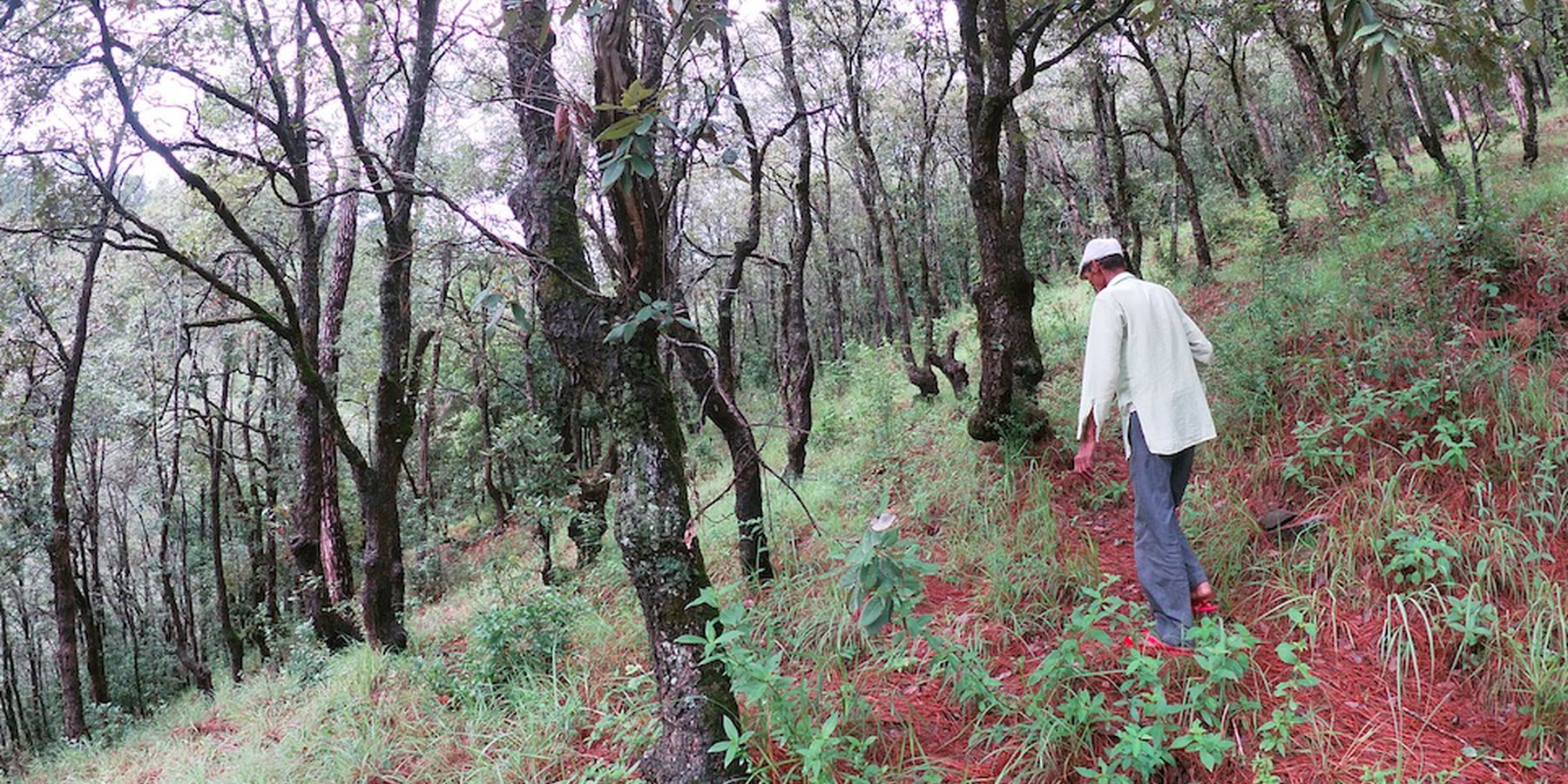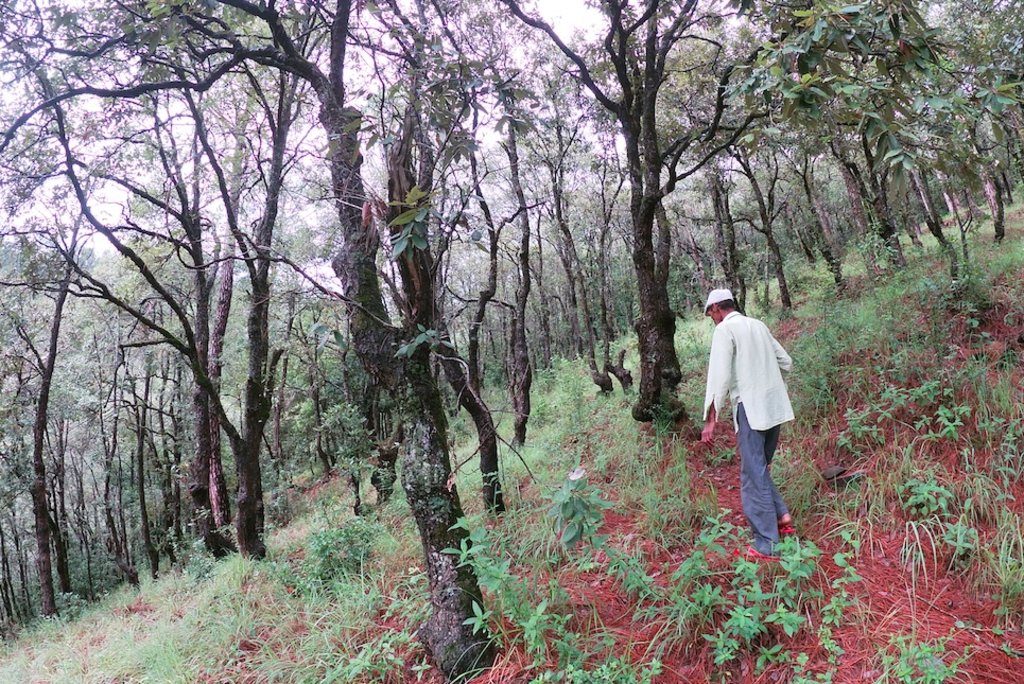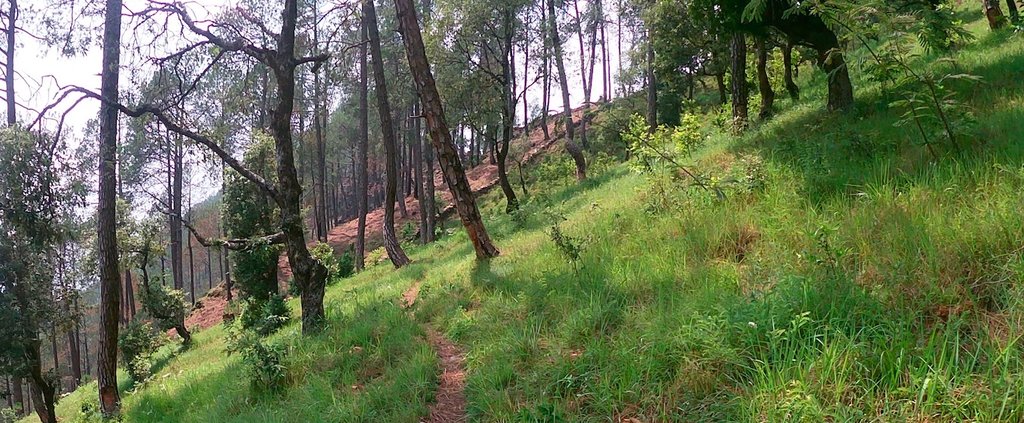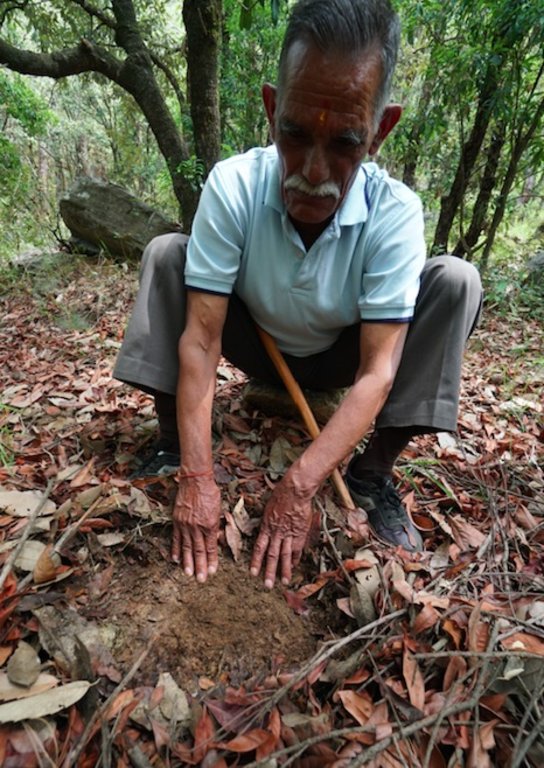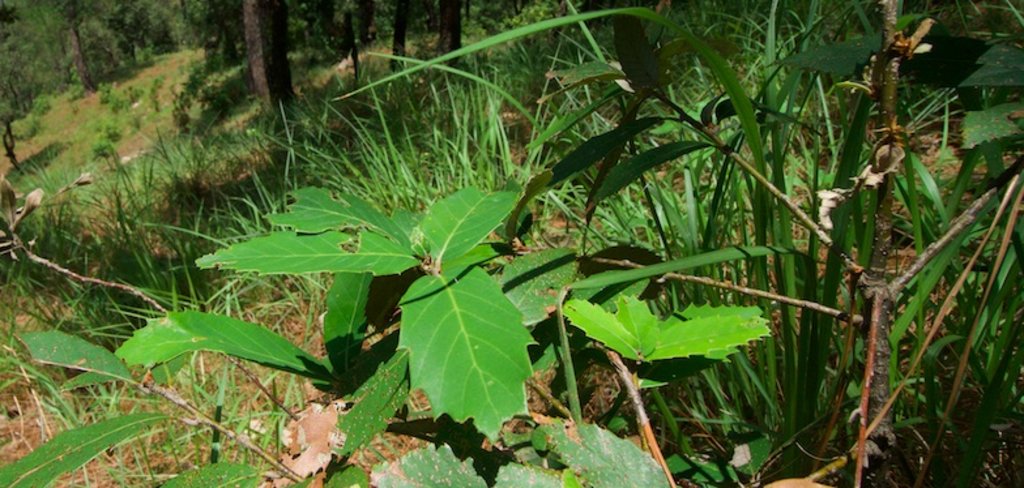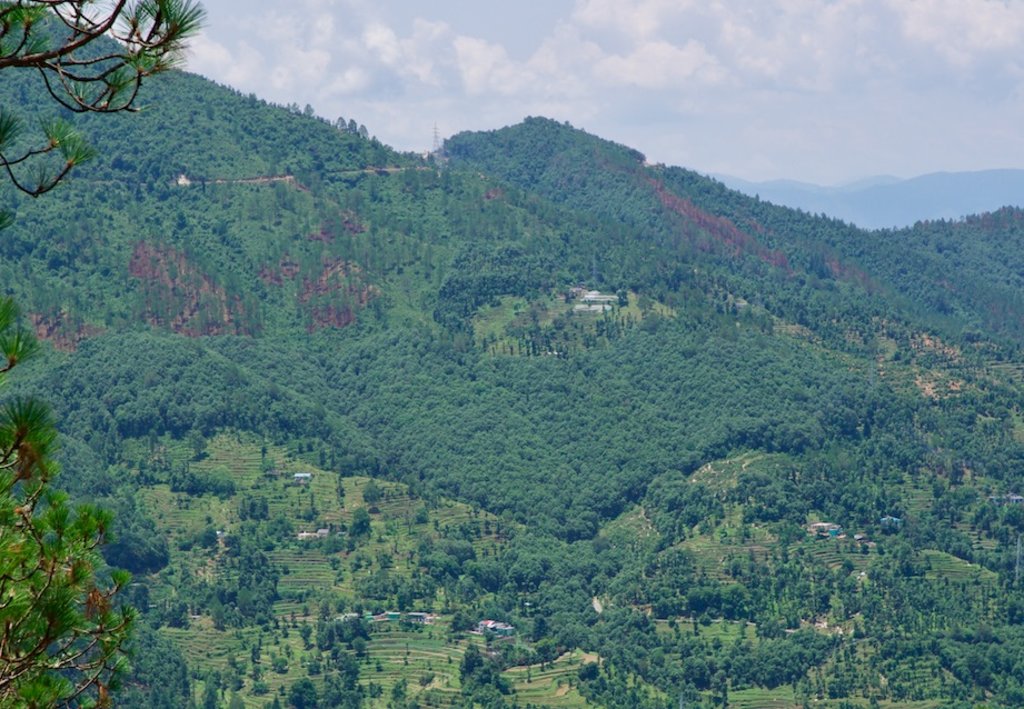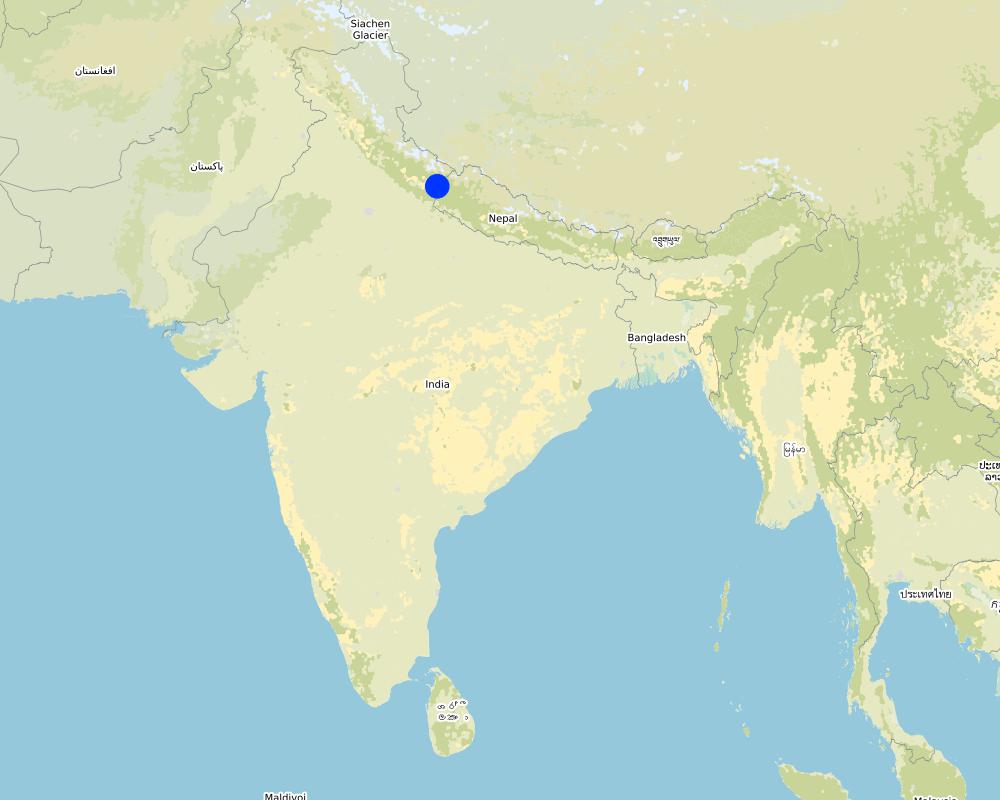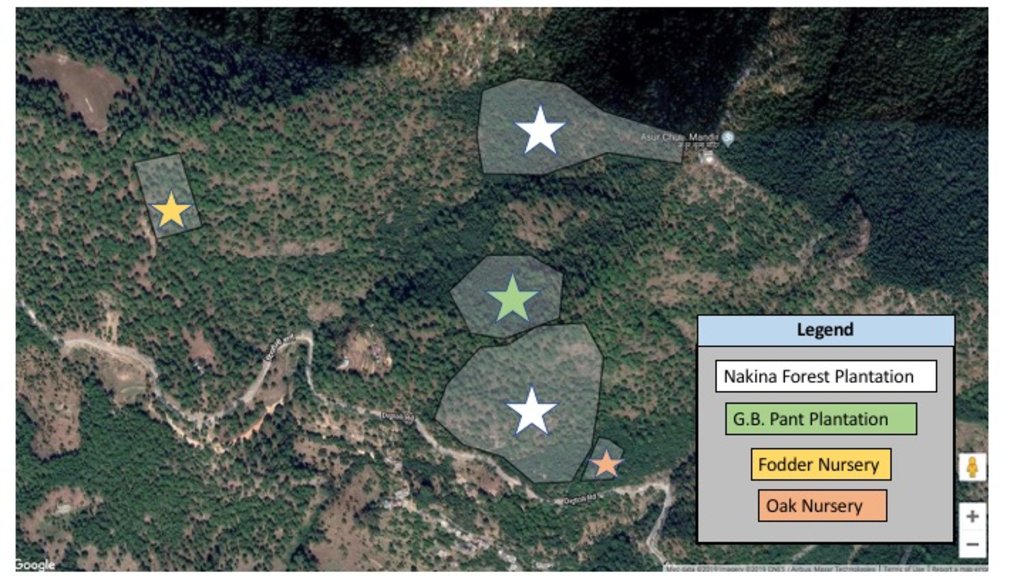Broadleaf Plantations, Assisted Tree Regeneration and Fodder Nurseries for Sustainable Forest Management [印度]
- 创建:
- 更新:
- 编制者: Jaclyn Bandy
- 编辑者: –
- 审查者: Hanspeter Liniger
Trees: Banj Oak (Quercus leucotricophora/glauca), Phalat (Quercus lanata), Fodder: Napier grasses, Bhimal (Grewia optiva), Khadik (Celtis australis)
technologies_5243 - 印度
查看章节
全部展开 全部收起1. 一般信息
1.2 参与该技术评估和文件编制的资源人员和机构的联系方式
关键资源人
土地使用者:
Joshi Jagdamba Prashad
Sarpanch (Head) of Nakina Community Forest (Van Panchayat)
印度
土地使用者:
Pandey Basant Ballabh
Cucumber Farmer, Nakina Village
印度
有助于对技术进行记录/评估的项目名称(如相关)
Book project: where the land is greener - Case Studies and Analysis of Soil and Water Conservation Initiatives Worldwide (where the land is greener)有助于对技术进行记录/评估的机构名称(如相关)
ICIMOD International Centre for Integrated Mountain Development (ICIMOD) - 尼泊尔有助于对技术进行记录/评估的机构名称(如相关)
G.B. Pant Institute of Himalayan Einvironment & Development (G.B. Pant Institute of Himalayan Einvironment & Development) - 印度1.3 关于使用通过WOCAT记录的数据的条件
编制者和关键资源人员接受有关使用通过WOCAT记录数据的条件。:
是
1.4 所述技术的可持续性声明
这里所描述的技术在土地退化方面是否存在问题,导致无法被认为是一种可持续的土地管理技术?:
否
注释:
The land is suitable for afforestation and fodder nurseries. There are currently no signs of over exploitation with regards to natural resource use in the plantation area of the Nakina Forest.
1.5 参考关于SLM方法(使用WOCAT记录的SLM方法)的调查问卷
2. SLM技术的说明
2.1 技术简介
技术定义:
Natural assisted regeneration of broadleaved species, a small oak plantation and a fodder nursery have been established in the Nakina community forest (intervention area: 10 ha), supporting fodder tree species such as Banj Oak and Falyaat, as well as various subtropical temperate fodder grass species. This has improved the livelihood of the land-users by supporting the health and productivity of the forest, increasing the availability of fuel wood, fodder and groundwater for spring restoration.
2.2 技术的详细说明
说明:
1. The technology is applied in a natural environment and is located about 1km away from the settlement and the agriculture land of Nakina Village. The village has access to its own forest, which covers a geographical area of 114 hectare. Of this, 94 hectares come under the Village Forest Council, locally referred to as the Van Panchayat.
2. Characteristics of Technology:
a. Broadleaf species have been established over 7 hectares through natural assisted tree regeneration methods. These include Banj Oak (Quercus leucotrichophora), Falyaat (Quercus glauca), Koeraal (Bauhinia verigata), Bhimal (Grewia optiva), Padam Paaya (Prunus cerasoides), Haradh (Terminalia chebula), Reetha (Sapindus Mukorossi), Utees (Alnus napalensis), Ainyar (Lyonia ovalifolia), Khadik (Celtis australis).
b. Nakina Van Panchayat has made an oak plantation site of 2 hectares in collaboration with G.B. Pant Research Institute.
c. A fodder nursery covering 1 hectare hosts a variety of subtropical (Napier: Pennisetum purpureum, Aus, Ginni) and temperate grasses (Guchhi, Dolni, Italian rye: Lolium multiflorum). It was established with the assistance of the NGOs Swati Gramodyog Sansthan and the Himalayan Sewa Samiti. Extraction of fodder leaves and timber are restricted and regulations managed by the Van Panchayat (community forest council).
Purposes/functions:
-Increase trees and grasses to improve availability of fuel and fodder for community, as well as enrich biodiversity.
-Plantation is on a mountain slope (+25% slope), so it will help in preventing soil erosion and landslides.
-Improve soil and water conservation, prevention of surface run-off, support groundwater recharge and spring rejuvenation.
Major activities/Inputs needed to establish and maintain technology:
1. Activities for Assisted Natural Regeneration: protect and facilitate the growth of parent trees inherently present in the area and their regenerations, rather than establishment of entire plantation
2.Activities for the oak plantation: Selection and seed provision of appropriate tree species, clearing of vegetation and preparation of forest top soil, leveling of soil, digging of plantation pits, sowing weeding, watering, occasional pruning, propagation of trees from cuttings, dead sapling replacement, establishment of barrier/fencing for protection from fire.
3. Activities for fodder nursery:- Selection and seed provision of appropriate grass species and polypot materials, preparation of seedbeds; clearing of vegetation, removal of stones/large roots, ploughing/hoeing, mixing sand and compost on areas with poor soil, sowing seeds pre-monsoon, weeding and watering seedlings, propagation from seed or root cuttings, dead sapling replacement, establishment of barrier/fencing protection from fire.
Benefits/Impacts:
•Restores productivity and fodder/fuelwood availability
•Ecosystem stability
•Enhancement of biological diversity to degraded lands.
•Control landslide and soil erosion
•Control forest fire.
•Maintain wildlife habitat
•Increase livelihood of local people, decrease time spent collecting fodder
•Storage carbon on the forest help to reduce the CO2 in the atmosphere.
Likes:
This technology is properly functioning in the implementation area and local people have received many benefits from sustainable managing their natural resources rather than receiving incentives for institutional support, local people of the Nakina village are strongly active to protect the forest with their own coordination.
Dislikes:
1.Improve wildlife habitat, which may increase human wildlife conflicts as it is near to agriculture land and settlements.
2.Require regular maintenance activities, which require organization within the community and can increase periodic workload depending on level of participation
2.3 技术照片
2.5 已应用该技术的、本评估所涵盖的国家/地区/地点
国家:
印度
区域/州/省:
Uttarakhand
有关地点的进一步说明:
Nakina Village, Pithoragarh Bloc
具体说明该技术的分布:
- 适用于特定场所/集中在较小区域
技术现场是否位于永久保护区?:
是
如果是,请具体说明:
Nakina Van Panchayat (community forest)
Map
×2.6 实施日期
如果不知道确切的年份,请说明大概的日期:
- 10-50年前
2.7 技术介绍
详细说明该技术是如何引入的:
- 通过土地使用者的创新
- 通过项目/外部干预
注释(项目类型等):
After the Nakina Van Panchyat was established in 1952 they already had experience working on plantations. During the British-era, timber extraction, pine plantations and prescribed fire exploded in the region. Much of the oak forests were reverted to pine, and many broadleaved species like were overexploited for construction, fuelwood, and fodder. Nakina's self-initiated plantation efforts were done in hopes to restore it to its original state.
Other supporting organizations and institutions have recognized the need for further support for the following reasons: demand for fuel and fodder is still insufficient during the dry season, water scarcity has become a prevalent issue, and biological interventions are necessary to improve and sustain ecosystem services. Due to the expressed interest and dedication of the community, these projects have been accomplished.
3. SLM技术的分类
3.1 该技术的主要目的
- 改良生产
- 减少、预防、恢复土地退化
- 保护生态系统
- 结合其他技术保护流域/下游区域
- 保持/提高生物多样性
- 降低灾害风险
- 适应气候变化/极端天气及其影响
- 创造有益的经济影响
3.2 应用该技术的当前土地利用类型
同一土地单元内混合使用的土地::
是

牧场
集约放牧/饲料生产:
- 收割和携带/零放牧
动物类型:
- 牛 - 奶制品
- 山羊
是否实行作物与牲畜的综合管理?:
是
如果是,请具体说明:
Compost was made from manure of livestock for plantation and fodder nursery preparation.
产品和服务:
- 肉类
- 奶类

森林/林地
- (半天然)天然森林/林地
- 植树造林
(半天然)天然森林/林地:具体说明管理类型:
- 选伐
(半)天然林类型:
- 亚热带干燥林天然植被
植树造林:说明树种的起源和组成:
- 混交品种
植树造林类型:
- 亚热带干林人工林 - 阔叶林
- Banj Oak (Quercus leucotricophora), Falyaat (Quercus glauca), Koeraal (Bauhinia verigata), Bhimal (Grewia optiva), Padam Paaya (Prunus cerasoides), Haradh (Terminalia chebula), Reetha (Sapindus Mukorossi), Utees (Alnus napalensis), Ainyar (Lyonia ovalifolia)
以上的树木是落叶树还是常绿树?:
- 落叶植物
产品和服务:
- 木材
- 薪材
- 其它森林产品
- 放牧/啃牧
- 自然保持/保护
3.3 由于技术的实施,土地使用是否发生了变化?
由于技术的实施,土地使用是否发生了变化?:
- 否(继续问题3.4)
3.4 供水
该技术所应用土地的供水:
- 雨养
3.5 该技术所属的SLM组
- 天然和半天然森林管理
- 森林种植管理
- 改良的地面/植被覆盖
3.6 包含该技术的可持续土地管理措施

植物措施
- V1:乔木和灌木覆盖层
- V2:草和多年生草本植物
- V3:植被的清理
- V4:更换或清除外来/入侵物种
- V5:其它

管理措施
- M1:改变土地使用类型
- M2:改变管理/强度级别
- M3:根据自然和人文环境进行布局
- M5:物种组成的控制/变化
3.7 该技术强调的主要土地退化类型

土壤水蚀
- Wt:表土流失/地表侵蚀
- Wg:冲沟侵蚀/沟蚀
- Wm:块体运动/滑坡
- Wo:场外劣化效应

化学性土壤退化
- Cn:肥力下降和有机质含量下降(非侵蚀所致)
- Ca:酸化

物理性土壤退化
- Pc:压实
- Pk:熟化和结壳
- Pi:覆土
- Pu:由于其他活动而导致生物生产功能的丧失

生物性退化
- Bc:植被覆盖的减少
- Bh:栖息地丧失
- Bq:数量/生物量减少
- Bf:火灾的有害影响
- Bs:质量和物种组成/多样性的下降
- Bl:土壤寿命损失
- Bp:害虫/疾病增加,捕食者减少

水质恶化
- Ha:干旱化
- Hs:地表水良变化
- Hg:地下水/含水层水位的变化
- Hp:地表水水质下降
- Hq:地下水水质下降
3.8 防止、减少或恢复土地退化
具体数量名该技术与土地退化有关的目标:
- 减少土地退化
- 修复/恢复严重退化的土地
4. 技术规范、实施活动、投入和成本
4.1 该技术的技术图纸
技术规范(与技术图纸相关):
G.B. Pant Plantation: 2 Hectare, pits of (30 cm X 30cm X 45cm) were dug along contour lines, spacing of pits is not less than 2x2 m, about 2,000 Quercus saplings were planted.
Nakina Broadleaf Plantation: 7 Hectare, pits of (30 cm X 30cm X 45cm) were dug along contour lines, spacing of pits is no less that 2x2 m, about 15,000 trees have been planted and the forest is being continually managed in the area.
Species: Banj Oak (Quercus leucotrichophora), Falyaat (Quercus glauca), Koeraal (Bauhinia verigata), Bhimal (Grewia optiva), Padam Paaya (Prunus cerasoides), Haradh (Terminalia chebula), Reetha (Sapindus Mukorossi), Utees (Alnus napalensis), Ainyar (Lyonia ovalifolia), Khadik (Celtis australis)
Fuelwood cutting (lopping), fodder collection, and selective clear cutting for Quercus leucotrichophora and other broadleaved species is done between Nov- April.
Fodder Nursery: 20 Quintals (20,000 kg) of various grassroot slips over 1 Hectare. This provides +175 tonnes/year. (Subtropicals species: napier, aus, ginni, Temperate species: guchhi, dolni, italian rye)
Planting: Grasses are planted during the months of June-July at the advent of rainy season, about 10 cm deep vertically and at a spacing of 45 x 30 cm apart.
Propagation: grasses forms clumps during its growth period. The clump when broken gives a number of small units known as slips, which are the units of propagation and on planting, they establish as individual plants. While preparing the slips for planting, fibrous roots and leaves are be trimmed off. Cuttings with 2 nodes from the middle portion of moderately matured stems (3 – 4 months old) were planted in a slanting position at one side of the ridges with one node buried in the soil. The underground node develops roots and shoots while the upper node shoots only. The soil around the stem is pressed tightly. Farm yard manure is applied after harvest (application rate varies; estimation is 5-8 tonnes). Annually about 6 to 8 cuts are possible.
Oak Nursery: 0.25 ha. The nursery bed is rectangular and measures about 100m x 25 m. The seedlings are uprooted by hand from a seedbed and transplanted (bare-root transplanting). The nursery is on a gently sloping land (23%). Seedlings with poor lateral root development are culled out.
Oak Plantation Alternative:
Acorns are collected and put in water for 24 hours. Acorns that sink are immediately sown in a well tilled seedbed 2-5 cm deep, 15 cm from each other and covered with a thin layer of firm soil. Beds are mulched with straw or leaves. However, not every acorn will germinate and animal predation of acorns can be an issue. In general, probability of success is lower than with seedlings.
作者:
Jaclyn Bandy
日期:
25/07/2019
技术规范(与技术图纸相关):
Google Map of Plantations and Fodder Nursery locations
作者:
Jaclyn Bandy
日期:
25/07/2019
技术规范(与技术图纸相关):
Project Budget with Nakina Village and NGO Himalayan Sewa Samiti: Fodder Nursery, 1 hectare and Assisted Natural Regeneration 97 Hectares)
(Citation: Detailed Project Report: Natural Resource Based Livelihood Project in the Gorang Ghati Cluster, NGO Himalayan Sewa Samiti, Submitted to: Sir Ratan Tata Trust (SRTT) Forest Works Manual, 2015 Forest Research Institute, Dehradun, Uttarakhand)
作者:
J Bandy
技术规范(与技术图纸相关):
Project Budget for Afforestation of Nakina Community Forest and G.B. Pant Institute of Himalayan Environment and Development: Broadleaf Plantation (2 hectares)
(Citation: Forest Works Manual, 2015 Forest Research Institute, Dehradun, Uttarakhand)
作者:
J Bandy
4.2 有关投入和成本计算的一般信息
具体说明成本和投入是如何计算的:
- 每个技术区域
注明尺寸和面积单位:
Afforested Community Forest: 7 hectares, G.B. Pant Plantation: 2 hectares, Fodder Nursery: 1 hectare
其它/国家货币(具体说明):
INR
如相关,注明美元与当地货币的汇率(例如1美元=79.9巴西雷亚尔):1美元=:
70.0
注明雇用劳工的每日平均工资成本:
400 INR
4.3 技术建立活动
| 活动 | 时间(季度) | |
|---|---|---|
| 1. | Plantations: Survey, demarcation, clearance of shrubs, bushes, Lantana (invasive species) | Pre-monsoon |
| 2. | Earth work for leveling, Digging pits (30 cm X 30cm X 45cm) along contour lines, spacing of pits no less that 2x2 m, filling of pits with soil/manure mixture | Early June |
| 3. | Planting of saplings: roots of the plants kept straight and the plant put straight in vertical position; done by digging with the help of a stick or small crow bar | Early July |
| 4. | Note: Species like Akhrot, Angu, Maple, Pangar, Poplar, Salix, Utis etc. are planted in winter months | January/February |
| 5. | Dead, dying or dry plants are replaced within 15 days of completion of planting work | Mid June |
| 6. | Thanwalas (semicircular pit) about 15 cm deep, 25-30 cm apart from the plant were dug for rainwater retention/infiltration | Mid June |
| 7. | Weeding after first significant rains | Monsoon |
| 8. | Fodder Nursery: Survey, demarcation, clearance of shrubs, bushes, Lantana (invasive species) | Pre-monsoon |
| 9. | Plowing/hoeing land, collection and soil, sand, manure preparation (4:2:1 ratio) and seedbed preparation | Pre-monsoon |
| 10. | Planting of each cane/rootsplit in holes 15-30 cm deep, with a spacing of 0.5m x 0.5m | Pre-monsoon |
| 11. | Cutting and Harvesting |
注释:
Oak Plantation: Seeds are collected from dominant oak trees that exhibit superior phenotypic traits such as tall straight trunks, good diameter growth rates and well-developed crowns (branches/leaves)
Cuttings:
4.4 技术建立所需要的费用和投入
| 对投入进行具体说明 | 单位 | 数量 | 单位成本 | 每项投入的总成本 | 土地使用者承担的成本% | |
|---|---|---|---|---|---|---|
| 劳动力 | Plantation Community Manual labour | person-days | 400.0 | 400.0 | 160000.0 | 50.0 |
| 劳动力 | Skilled labour (advisor, experts) | person-days | 7.0 | 2000.0 | 14000.0 | |
| 劳动力 | Fodder Nursery Raising | Total Cost | 1.0 | 25000.0 | 25000.0 | 25.0 |
| 设备 | Axe, Crow bar, Wheel barrow | pieces | 10.0 | 1500.0 | 15000.0 | 100.0 |
| 设备 | Digging forks, Hammers, Hoes, Spade | pieces | 10.0 | 1500.0 | 15000.0 | 100.0 |
| 设备 | Scissors, Pruning knives/shears, Budding and Grafting Knives/Tape | pieces | 10.0 | 700.0 | 7000.0 | 50.0 |
| 植物材料 | Fodder Grass/20 Quintals of Grassroot slips | Total Cost | 1.0 | 45000.0 | 45000.0 | 50.0 |
| 植物材料 | Plantation Material, 3.88 INR per Sapling x 1000 Sapling per hectare x 7 hectare | Total Cost | 1.0 | 27160.0 | 27160.0 | 50.0 |
| 肥料和杀菌剂 | Soil/Water Conservation and Soil Fertility Measures: 5,500 INR per Hectare x 2 | Total Cost | 1.0 | 11000.0 | 11000.0 | 100.0 |
| 肥料和杀菌剂 | Nakina Forest: Assisted Natural Regeneration preparation and composting | Total Cost | 1.0 | 2000.0 | 2000.0 | 100.0 |
| 肥料和杀菌剂 | Fodder Nursery composting | Total Cost | 1.0 | 1000.0 | 1000.0 | 100.0 |
| 其它 | Plantation Transportation, Pitting, Planting: 6.9 INR per plant X 1000 sapling x 2 hectare | Total Cost | 1.0 | 13800.0 | 13800.0 | 50.0 |
| 其它 | Fodder Nursery (Rootstock Purchase, Transportation) | Total Cost | 1.0 | 5500.0 | 5500.0 | 50.0 |
| 其它 | Nakina Village: Assisted Natural Regeneration Activities in Planted Plots, 10,000 INR per hectare X 7 hectares x 3 years | Total Cost | 1.0 | 30000.0 | 30000.0 | 100.0 |
| 技术建立所需总成本 | 371460.0 | |||||
| 技术建立总成本,美元 | 5306.57 | |||||
如果土地使用者负担的费用少于100%,请注明由谁负担其余费用:
UTFD (Forest Department): funds mobilized by the MNEGRA (Mahatma Gandhi National Rural Employment Guarantee Act), JICA, G.B. Pant, NGO Himalayan Sewa Samiti (Sir Ratan Tata Trust's Contribution)
注释:
For G.B. Pant Plantation and Nakina Forest Plantation:
On average we estimated a maximum of 10 people worked on establishing the technology/day = 400 x 10 = 4000 (labor cost/day): 4,000 X 40 days = 160,000 INR Total Cost
Some of the community laborers were compensated for the initial phase of establishing the plantation with G.B. Pant Plantation, but for the Nakina Plantation most of the work was voluntary by the community over many years. Nakina Van Panchayat has a joint bank account (Almora Urban Cooperative Bank) with officials from the Forest Department. Money from the Forest Department/ JICA (Japanese International Cooperation Agency) gets deposited there. A portion of this is used to compensate the village workers (~400 INR/day) .
NGO Himalayan Sewa Samiti (HSS) was involved in supporting the fodder nursery and some plantation support.
For the original project budget outline for the Fodder Nursery, please see the attached document in the Technical Drawing section from the NGO HSS.
For further details on the plantation budget, please see the tables in the Technical Drawing section from the Forest Works Manual/Schedule of rates for forest work in Uttarakhand.
4.5 维护/经常性活动
| 活动 | 时间/频率 | |
|---|---|---|
| 1. | Second weeding done in September, followed by a third weeding after the winter rains. | Post-monsoon |
| 2. | A Chowkidar (forest watch guard) is deputed for five years in the plantation area to look after it | Post-planting |
| 3. | Periodical weeding and removal of grasses suppressing the plants, maintenance and repair of inspection paths | Year round |
| 4. | Fire Control: Keeping regular watch over the plantation area during the fire season, cleaning of the outer periphery of the plantation area in two meter width | Dry season |
| 5. | Collective help and co-operation with the villagers in the protection of the plantation; checks on fodder extraction/allowance, prevention of trespassers (human/wildlife) | Year round |
| 6. | During the second year, dead plants are replaced by planting fresh saplings (ca. 20%) | Onset of monsoon |
| 7. | Fodder grasses: propagation from cuttings or from root slips | |
| 8. | Fodder Grasses: Harvesting of grasses every 6-8 weeks, maintaining a stubble height of 5-10 cm from the ground level at each harvest to avoids weakening of root system |
4.6 维护/经常性活动所需要的费用和投入(每年)
| 对投入进行具体说明 | 单位 | 数量 | 单位成本 | 每项投入的总成本 | 土地使用者承担的成本% | |
|---|---|---|---|---|---|---|
| 劳动力 | Maintenance of nursery | Total Cost/Year | 1.0 | 3000.0 | 3000.0 | 25.0 |
| 劳动力 | Maintenance of plantations | Total Cost/Year | 1.0 | 4000.0 | 4000.0 | 25.0 |
| 技术维护所需总成本 | 7000.0 | |||||
| 技术维护总成本,美元 | 100.0 | |||||
如果土地使用者负担的费用少于100%,请注明由谁负担其余费用:
UTFD (Forest Department): funds mobilized by the MNEGRA (Mahatma Gandhi National Rural Employment Guarantee Act), JICA, NGO Himalayan Sewa Samiti (Sir Ratan Tata Trust's Contribution)
注释:
Please see estimated maintenance costs attached in references.
In general, the land users bear the labor costs of maintenance, but they received inputs and other support to maintain the fodder nursery and plantations for a few years (2-3) after the projects were executed. Otherwise, remaining funds in the joint bank account with Nakina Van Panchayat and UTFD/JICA are accessed for necessary supplies and labor compensation.
4.7 影响成本的最重要因素
描述影响成本的最决定性因素:
-Length and amount of available funding, as plantation projects require substantial investment and long term care.
-Damage or survival rate of the saplings/trees/fodder species can be severely affected by climatic, anthropogenic, or wildlife disturbances. The success and cost of a plantation and nursery project can vary widely depending on size, topographic characteristics, access, labor availability and overall appropriateness of site selection.
5. 自然和人文环境
5.1 气候
年降雨量
- < 250毫米
- 251-500毫米
- 501-750毫米
- 751-1,000毫米
- 1,001-1,500毫米
- 1,501-2,000毫米
- 2,001-3,000毫米
- 3,001-4,000毫米
- > 4,000毫米
指定年平均降雨量(若已知),单位为mm:
1500.00
有关降雨的规范/注释:
Monsoon- mid-June to mid-September; July and August are the rainiest months and the temperature is warm and moist; between 70-85% of the annual precipitation occurs in the monsoon season
Seasons
a. Winter or Cold weather (mid Dec. - mid March)
b. Summer or hot weather (mid March - mid June)
c. Season of general rains (South - West monsoon season)
d. Season of retreating monsoon (mid September to mid November)
注明所考虑的参考气象站名称:
India Meteorological Department, Meteorological Centre Dehradun
农业气候带
- 半湿润
The overall climatic condition in the Pithoragarh district is governed by the southwest monsoon. It has a sub-tropical to temperate climate, with three pronounced seasons; summer, winter, and monsoon. The hilly terrain of the Himalayan region has snow cover and is cold during winter with snowfall normally occurring during the months of December to March.
Temperature- The temperature ranges from 0°C to 10°C in winter and from 8°C to 33°C in summer season. However, there is no meteorological observatory in the district. The account of the climate is based mainly on the records of the observations in the neighboring districts where similar meteorological conditions prevail. Variations in temperature are considerable from place to place and depend upon elevation as well as aspect. As the insolation is intense at high altitudes, in summer temperatures are considerably higher in the open than in the shade.
5.2 地形
平均坡度:
- 水平(0-2%)
- 缓降(3-5%)
- 平缓(6-10%)
- 滚坡(11-15%)
- 崎岖(16-30%)
- 陡峭(31-60%)
- 非常陡峭(>60%)
地形:
- 高原/平原
- 山脊
- 山坡
- 山地斜坡
- 麓坡
- 谷底
垂直分布带:
- 0-100 m a.s.l.
- 101-500 m a.s.l.
- 501-1,000 m a.s.l.
- 1,001-1,500 m a.s.l.
- 1,501-2,000 m a.s.l.
- 2,001-2,500 m a.s.l.
- 2,501-3,000 m a.s.l.
- 3,001-4,000 m a.s.l.
- > 4,000 m a.s.l.
说明该技术是否专门应用于:
- 凹陷情况
关于地形的注释和进一步规范:
Altitude of evaluated sites: 1850-1990m
Slope: 23-30%
5.3 土壤
平均土层深度:
- 非常浅(0-20厘米)
- 浅(21-50厘米)
- 中等深度(51-80厘米)
- 深(81-120厘米)
- 非常深(> 120厘米)
土壤质地(表土):
- 粗粒/轻(砂质)
- 中粒(壤土、粉土)
土壤质地(地表以下> 20厘米):
- 中粒(壤土、粉土)
表土有机质:
- 中(1-3%)
- 低(<1%)
如有可能,附上完整的土壤描述或具体说明可用的信息,例如土壤类型、土壤酸碱度、阳离子交换能力、氮、盐度等。:
Mountain/hill soils are a collective name given to various types of soils found under the following conditions :
-under sub-tropical, temperate and sub-alpine conditions
-under various forest types
Characteristics: very thin, fertile, and may be less than a centimeter deep on steep slopes; they are mixed with pebbles, shingles (a mass of small rounded pebbles), and gravels; they have a low-medium water holding capacity. Angular and subangular fragments of parent rock may be found mixed with the lower layers of the mountain and hill soils.
Texture: varies from loamy to sandy loam.
Soil Reaction: ranges from acidic to neutral (pH 4.6 to 6.5)
Organic Matter content: 1-5%
Ferrugenous red roils are found in this district and are well developed over Himalayan rocks (quartzite, biotite schist, amphibolite schist). They are free of carbonates and deficient in nitrogen, humus and phosphorus, light textured, porous, and friable (brittle/crumbly). The soil depth ranges from about 10cm-75 cm. These soils may be grouped into two on basis of morphology
1. Red earths- loose, friable topsoil rich in secondary concretions (hard, compact mass of matter formed by the precipitation of mineral cement within the spaces between particles, and is found in sedimentary rock or soil)
2. Red loam- argillaceous soils having a blocky structure (argillaceous minerals may appear silvery upon optical reflection and are minerals containing substantial amounts of clay-like components, e.g. argillaceous limestones are limestones consisting predominantly of calcium carbonate, but including 10-40% of clay minerals)
Brown soil: is found particularly under dense broadleaved temperate and sub-alpine forests. There occurs a thick layer of humus on the forest floor (made of decomposed leaves, branches, twigs) and the topsoil is extremely rich in humus
Podsolic Soil: soil that has developed in humid/temperate conditions usually under coniferous forests (e.g. deodar, blue pine, fir, spruce) over quartzite, granites, schists and gneiss.
(Citation: Kumaun: The Land and the People, Sharad Singh Negi (1993)
5.4 水资源可用性和质量
地下水位表:
5-50米
地表水的可用性:
中等
水质(未处理):
良好饮用水
水质请参考::
地下水
水的盐度有问题吗?:
否
该区域正在发生洪水吗?:
否
关于水质和水量的注释和进一步规范:
Quantity: Water crisis has been a perennial problem in both the rural and urban areas of the Pithoragarh district
There is scarcity of safe drinking water of the villages in the study area. Hand pumps are often not functioning, pipe-water schemes are unreliable and the spring discharges have reduced during the dry season. Hand-pumped water often has a high iron content and bitter taste. Poor quality of groundwater in some of the naulas is mainly due to misuse and/or disuse of the structures.
A block-district groundwater resource estimation could not be carried out as the area is hilly (with slope >20%) and in major part aquifers are small, isolated bodies, and groundwater abstraction is done mainly through hand pumps and springs with small discharges.
However, we collected some physicochemical parameters that indicate the water (sourced from springs) is of good quality:
Water Quality Parameters of Springs:
pH: 6.29-8.18
Temp: 19.0-23.5 ºC
Electrical Conductivity: 109-504 µmsiemens
Total Dissolved Solids: 75-385 ppm
5.5 生物多样性
物种多样性:
- 中等
栖息地多样性:
- 中等
关于生物多样性的注释和进一步规范:
Uttarakhand has more than 7000 species of medicinal plants and 500 species of fauna. Floral diversity contributes 31% of total floral density of India. Fauna contributes just 1.58% of the total faunal density of the country. There are 119 endemic species of flowering plants in the state that exhibited 2.35% endemism and 35 faunal endemic species. Because it lies at the juncture of India, Nepal and the Tibeten Autononmous region, there often cases of poaching and smuggling of wildlife contrabands, including bear bile, musk pods and leopard skins through the borders. Yarsa Gumba Ophiocordyceps sinensis, commonly known as Caterpillar Fungus, is also illegally traded transboundary in the region, together with various plant species. Due to anthropogenic impacts, changes is soil quality, and climatic elements, the biodiversity of our study site is not as high as in other areas of the Pithoragarh district.
Citation: Sundriyal, M. & Sharma, B. (2016). Status of Biodiversity in Central Himalaya, Applied Ecology and Environmental Sciences, 4( 2), 37-43.
5.6 应用该技术的土地使用者的特征
定栖或游牧:
- 定栖的
生产系统的市场定位:
- 生计(自给)
- 混合(生计/商业)
非农收入:
- 收入的10-50%
- > 收入的50%
相对财富水平:
- 贫瘠
个人或集体:
- 团体/社区
机械化水平:
- 手工作业
性别:
- 女人
- 男人
土地使用者的年龄:
- 青年人
- 中年人
- 老年人
说明土地使用者的其他有关特征:
With recent development in Pithoragarh, an influx of funds coming from outside sources has caused a decline in the importance of agriculture production, which in now marginalized, based on female labour, and mainly conducted for subsistence with little surplus to sell. High caste men do not work in cultivation at all, and male tasks such as ploughing are performed by the Scheduled Caste.
Although most women are still cultivating, their work has lost economic importance. For most families, the produce does not cover the needs of the household and surplus must be bought from the market. Many of the terraces that were formerly fruit orchards (mainly citrus) have been completely abandoned. Farming is less intensive and landholdings are small and fragmented. The main crops are wheat, millet, and pulses, but yields are low as the land is not irrigated. Less livestock (cows, goats, buffalo) is kept because of the labor involved. Very little capital is returned to farming. Crops produced for the markets in the plains are replacing traditional crops to sustain the household.
With exposure to the“Modern” lifestyle, new values have also been accepted. Two children are the norm (the ideal being one son and one daughter, but at least one son in a must). Although access to education is quite good, it does not seem to result in working careers for women.
5.7 应用该技术的土地使用者使用的平均土地面积
- < 0.5 公顷
- 0.5-1 公顷
- 1-2 公顷
- 2-5公顷
- 5-15公顷
- 15-50公顷
- 50-100公顷
- 100-500公顷
- 500-1,000公顷
- 1,000-10,000公顷
- > 10,000公顷
这被认为是小规模、中规模还是大规模的(参照当地实际情况)?:
- 小规模的
5.8 土地所有权、土地使用权和水使用权
土地所有权:
- 社区/村庄
土地使用权:
- 社区(有组织)
用水权:
- 自由进入(无组织)
- 社区(有组织)
土地使用权是否基于传统的法律制度?:
是
具体说明:
Under the Kumaun Panchayat forest rules of 1931 (amended in 1976): A Van Panchayat, (community forest council), can be formed out of non-private land within the settlement boundaries of a village. Accordingly, all villagers are members of the VP upon their approval by a Sub-Divisional Magistrate under the state Revenue Department. The members are collectively referred to as the general body, which selects the management committee members through a democratic process.
注释:
5-9 elected members assume control of the forest and the extent of villager use. They additionally raise funds and mobilize the village to protect and support sustainable land use. Presently 12,089 Van Panchayats are entrusted with the management of over 5,449.64 km2 of forests.
5.9 进入服务和基础设施的通道
健康:
- 贫瘠
- 适度的
- 好
教育:
- 贫瘠
- 适度的
- 好
技术援助:
- 贫瘠
- 适度的
- 好
就业(例如非农):
- 贫瘠
- 适度的
- 好
市场:
- 贫瘠
- 适度的
- 好
能源:
- 贫瘠
- 适度的
- 好
道路和交通:
- 贫瘠
- 适度的
- 好
饮用水和卫生设施:
- 贫瘠
- 适度的
- 好
金融服务:
- 贫瘠
- 适度的
- 好
注释:
The situation of infrastructure is difficult and inconsistent in the hill regions because of the terrain. The major infrastructural issues are drinking water and irrigation facilities, electricity, transportation and communication facilities and social infrastructure (housing and education). As for financial services, only the State Bank of India (SBI) is active in the hill regions where it is trying to achieve the objective of 100% financial inclusion. Some villages mentioned buying into into agricultural insurance in the past, however this was a temporary enterprise and they were never compensated after extreme climatic events that occurred and damaged over 70% of their crop.
Though infrastructure and education has generally improved over the years, institutional and marketing networks in the region aimed at supporting hill-farmers are lacking.
6. 影响和结论性说明
6.1 该技术的现场影响
社会经济效应
生产
饲料生产
SLM之前的数量:
2 ton/ha
SLM之后的数量:
30 ton/hectare
饲料质量
畜牧生产
木材生产
森林/林地质量
注释/具体说明:
Tree lopping for fodder was decreased by 15%
生产区域
土地管理
收入和成本
农业投入费用
注释/具体说明:
Decreased the amount of supplementary fodder required for livestock. The amount of grasses, fodder, and fuelwood has increased significantly.
工作量
注释/具体说明:
Less time spent collecting forest resources, as the area where the technology is near the village and supports fodder/fuelwood growth (broadleaf forest/oak nursery area)
社会文化影响
食品安全/自给自足
注释/具体说明:
Improved self sufficiency of village, as the technology has helped increase animal productivity (more fodder, better quality) and increased water availability.
健康状况
注释/具体说明:
Water condition has improved and people spend less time spent collecting fodder in the forest.
土地使用权/用水权
注释/具体说明:
There is less friction between the villages of Bhurimuni and Nakina. Nakina did not have to go ask for permission to access the Bhurimuni Naula for water during the dry season.
文化机会
注释/具体说明:
The improvements of forest resource security and resilience to disasters/climatic extremes have allowed the villagers have more free time to build up a communal gathering area for ceremonial events and festivals around the Vaishnavi Temple.
娱乐机会
注释/具体说明:
Recreation opportunities for villagers have increased. Particularly women, (some of whom are involved in a self help group and active Van Panchayat members), expressed that they saved approximately 1-2 hours/day in fodder collection time.
社区机构
注释/具体说明:
The partnerships formed between land-users, the Nakina Van Panchayat, the Forest Department and external institutions are leading examples of necessary cooperation between all levels of governance for project harmonization.
SLM/土地退化知识
注释/具体说明:
People are taking forest management seriously and making innovative plans for further SLM interventions, whether it be community-initiated or with the help of external institutions/agencies.
冲突缓解
注释/具体说明:
Conflict has decreased in the village do to increased availability of resources. The overall morale of the village is better and less frantic due to an improvement in dodder, fuel and water provision. This has further enhanced cooperation for interventions that require participation and effort in the community forest.
生态影响
水循环/径流
水量
注释/具体说明:
The technologies improve water holding capacity of the soil by decreasing runoff velocity and improve overall water storage.
水的回收/收集
地表径流
地下水位/含水层
蒸发
土壤
土壤水分
注释/具体说明:
Soil moisture of common land was increased by about 15%
土壤覆盖层
土壤流失
注释/具体说明:
Trees and other vegetation has helped mitigate displacement of soil from upstream areas to the lowlands
土壤堆积
土壤结壳/密封
土壤压实
养分循环/补给
土壤有机物/地下C
酸度
生物多样性:植被、动物
植被覆盖
注释/具体说明:
Vegetation growth and cover has improved due to more shade and water availability
生物量/地上C
植物多样性
注释/具体说明:
Increased species diversity due to improved moisture availability, soil conditions and microclimate.
外来入侵物种
动物多样性
注释/具体说明:
Provide more water and habitat for small animals/birds.
有益物种
注释/具体说明:
Healthy afforested areas provide more water, habitat, and protection for microorganisms and insect species. They support native grasses and vegetation.
栖息地多样性
减少气候和灾害风险
滑坡/泥石流
注释/具体说明:
Incidents of landslides decreased due to less surface flow velocity and soil destabilisation. Villagers also noted that there were that less displaced soil and sediment accumulation in the ravine that normally incurs damage from upstream debris flow in the monsoon season.
干旱影响
注释/具体说明:
Drought impacts decreased due improved surface and subsurface hydrological functioning in the upper watershed catchment areas. This increased microwatershed/ springshed groundwater stores and enhanced stream and spring flows in the dry season.
飓风、暴雨的影响
注释/具体说明:
Erosion impacts from extreme rain storms is reduced by decreasing flow velocity
碳和温室气体的排放
注释/具体说明:
Carbon storage is increased by the plantation. It has been previously studied that Uttarakhand Van Panchayat forests sequester carbon at the average rate of 3.5 t ha -1 yr-1. This varies depending on forest distribution, species and land management.
.
火灾风险
注释/具体说明:
The forest intervention area is protected by the villagers from anthropogenic and wild fires, therefore the forest has rehabilitated more quickly and has a lower risk of burning due to improved green vegetation cover and less flammable pine needle accumulation. In the case of pine forests, pine needles are a major source of fuel for fire and the removal of buildup remains a major challenge for the land users.
微气候
注释/具体说明:
Because of the interventions, vegetation/biomass, soil cover and water availability has improved and created a more suitable microclimate for microorganisms, plants, animals and people. The microclimate has improved due to decreased surface temperatures from exposed, bare soil or ground that is covered with pine needles. This improved microclimate is visible, as it has additionally allowed a wider range of species (grasses, shrubs, wildflowers, insects, birds) to inhabit the intervention site.
6.2 该技术的场外影响已经显现
水资源可用性
注释/具体说明:
Improved spring discharge in the peak dry season
旱季稳定可靠的水流
注释/具体说明:
Bhind and Vaishnavi Naulas (springs) have improved discharge in the peak dry season. According to villagers, there was little to no water available in May/June, and since 10 years the flow has returned due to the plantation efforts combination with structural technologies.
下游洪水
注释/具体说明:
impact of flash flood is minimized
下游淤积
注释/具体说明:
Helped slow down sediment and runoff
缓冲/过滤能力
注释/具体说明:
No direct evidence, but statements from the locals indicate that there are less sediments in the spring water ( due to improved soil infiltration and buffering capacity)
对邻近农田的破坏
注释/具体说明:
Less damage from runoff
对公共/私人基础设施的破坏
注释/具体说明:
Decreased intensity of runoff on the roadside and settlement below
6.3 技术对渐变气候以及与气候相关的极端情况/灾害的暴露和敏感性(土地使用者认为的极端情况/灾害)
渐变气候
渐变气候
| 季节 | 增加或减少 | 该技术是如何应对的? | |
|---|---|---|---|
| 年温度 | 增加 | 适度 | |
| 季雨量 | 旱季 | 减少 | 好 |
| 其他渐变气候 | Irregular rainfall patterns/ delayed monsoon | 增加 | 适度 |
气候有关的极端情况(灾害)
气象灾害
| 该技术是如何应对的? | |
|---|---|
| 局地暴雨 | 好 |
| 局地雷暴 | 好 |
| 局地雹灾 | 适度 |
气候灾害
| 该技术是如何应对的? | |
|---|---|
| 干旱 | 适度 |
| 森林火灾 | 好 |
水文灾害
| 该技术是如何应对的? | |
|---|---|
| 滑坡 | 适度 |
6.4 成本效益分析
技术收益与技术建立成本相比如何(从土地使用者的角度看)?
短期回报:
积极
长期回报:
非常积极
技术收益与技术维护成本/经常性成本相比如何(从土地使用者的角度看)?
短期回报:
稍微积极
长期回报:
非常积极
6.5 技术采用
- 11-50%
在所有采用这项技术的人当中,有多少人是自发的,即未获得任何物质奖励/付款?:
- 0-10%
注释:
Establishing plantations is often a substantial investment and external monetary and technical support is required by the land-users.
6.6 适应
最近是否对该技术进行了修改以适应不断变化的条件?:
否
6.7 该技术的优点/长处/机会
| 土地使用者眼中的长处/优势/机会 |
|---|
| Improves livelihood of villagers by addressing and significantly improving the fodder, fuel, water nexus. Increased fodder availability and decreased time spent collecting fodder/fuel in the forest has greatly benefited the village, and women in particular. Animal health and productivity has also increased. |
| Reduces erosion, improves catchment of runoff, increases groundwater availability and aids in spring recharge. |
| Supports soil quality and existing broadleaf forest; increased filtration, improved soil moisture and water availability. |
| Reduces impact of landslides and further downstream damage to settlements (water erosion, siltation) |
| 编制者或其他关键资源人员认为的长处/优势/机会 |
|---|
| Aligned with landuser |
| Improved microclimate, overall ecosystem health, and increased carbon sequestration. |
6.8 技术的弱点/缺点/风险及其克服方法
| 土地使用者认为的弱点/缺点/风险 | 如何克服它们? |
|---|---|
| Risk of damage to plantation and nursery from fires | Maintain protective barrier (wall and fire lane); more prominent live-fencing could be established around the fodder nursery, as it is under greater susceptibility to fire damage due to its location near the stone wall border and pine-dominant forest. |
| Moisture stress from weed competition reduces the growth of broadleaves | Consistent monitoring of weed and invasive species control (lantana) and eupatorium (Ageratina adenophora). |
| 编制者或其他关键资源人员认为的弱点/缺点/风险 | 如何克服它们? |
|---|---|
| There can be poor survival and slow growth of newly planted trees from damage while handling; e.g. the oak nursery has the potential to support many more plants, but it seems there is a need for more care when handling young broadleaved species. | Careful attention to plant handling, avoiding root damage, and appropriate timing of transplanting (e.g. avoid heat exposure) |
| Young oaks appeared somewhat nutrient deficient and are exposed in the forest; there were signs of animal intrusion or possibly damage by human crossing as the oak nursery is next to a small dirt trail. |
The survivability of the young oaks could be improved through mulching and establishing an enclosure or live fencing around the nursery. In the future, contour trenching and ponding can be also done before the plantations to improve the soil moisture. |
7. 参考和链接
7.1 信息的方法/来源
- 实地考察、实地调查
4: various villagers, Van panchayat community meeting
- 与土地使用者的访谈
2: Mr. Joshi and woman who is an active member in the Van Panchayat
- 与SLM专业人员/专家的访谈
3, NGO Himalayan Sewa Samiti,
2 G.B. Pant, Dr. Ranbeer Rawal, Dr. Subodh Airy
(现场)数据是什么时候汇编的?:
25/07/2019
7.2 参考可用出版物
标题、作者、年份、ISBN:
Plant Nursery Management: Principles and Practices, P. Ratha Krishnan Rajwant K. Kalia J.C. Tewari M.M. Roy, 2014, ISO 9001 : 2008
可以从哪里获得?成本如何?
http://www.cazri.res.in/publications/PRathaKrishnan.pdf
标题、作者、年份、ISBN:
Forest Works Manual and schedule of rates for Forestry Related Works, Uttarakhand, 2005, Forestry Research Institute, Dehradun
可以从哪里获得?成本如何?
https://nrega.nic.in/1ForestWorksManual-FRI.pdf
7.3 链接到网络上的相关信息
标题/说明:
Nursery Manual for Native Plants: A guide for tribal nurseries
URL:
https://www.fs.fed.us/rm/pubs_series/wo/wo_ah730.pdf
标题/说明:
Fodder and Forage Production
URL:
http://www.fao.org/3/T0706E/T0706E07.htm
标题/说明:
Nursery Technology
URL:
http://agritech.tnau.ac.in/forestry/nursery_major_activities.html
链接和模块
全部展开 全部收起链接
无链接
模块
无模块


